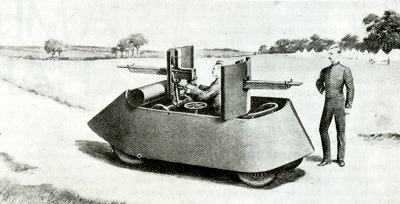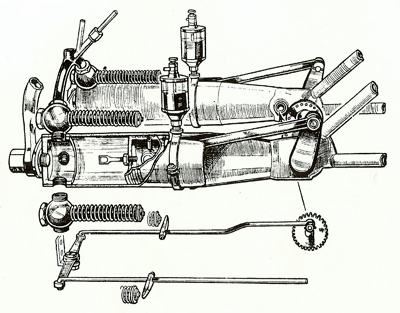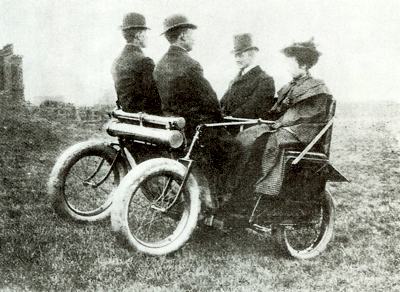'Airship' Pennington
The name of Pennington dominated the motoring press in the years 1895 - 1896, and his claims were regarded with great seriousness. E. J. Pennington first came to the public notice in 1890, when he was 32, by promoting a fanciful airship: his dreams of mechanical flight earned him the nickname 'Airship' Pennington. 'Supposing,' he would say, 'I have a cycle, screw-driven, making a mile a minute; just suppose that; then suppose I put aeroplanes on that machine, and they are well arranged and under good control, what then?'.
Thomas Kane & Company
By 1893, however, he had become obsessed with the
internal-combustion engine, and the following year persuaded Thomas Kane & Company of Chicago, who had been building light marine engines since 1885 to finance his experiments, and soon the first Kane-Pennington power unit was complete. Even by the unformed standards of the period, the Kane-Pennington was unorthodox, its drawn-steel-tube cylinders had only a minimum of water jacketing - and in its smaller forms, the Kane-Pennington had no water-jacket or cooling fins at all; and no carburettor, just a primitive drip-feed device.
Pennington's explanation of how the engine worked had a distinctly improbable air: 'All fluids take up a vast amount of heat in the change of vapour, and as my engine has no carburettor, but vapourises the charge directly in the cylinder, the fluid in vapourising absorbs the heat the cylinder walls have derived from the last explosion, and thus keeps the heat of the cylinders at a comparatively low point. 'The charge is exploded only when the effective stroke crank angle is 45 degrees, and previous to the delivery of the igniting spark to the charge, a mingling current of electricity is put through the air and gas in the cylinder, and by virtue of this non-igniting current delivered to the mixture, the heat absorption power or capacity, one or both, of gas in the cylinder is so incredibly augmented that the cylinder temperature can be, and actually is, so greatly lowered that the walls of the cylinders are kept cool to within convenient working limits.'
Today we understand the statement for what it is, a load of crap. But way back then, when the internal combusion engine was in its infancy, these words were somehow able to impress technical journalists, perhaps because the were impressed by anyone who could use longer words than they could, and the Kane-Pennington engine was afforded wide coverage in the technical press, including an article in The American Machinist on the 7th November 1895, which gave Henry Ford technical inspiration for the power unit of his Quadricycle.
The 'Long-Mingling Spark
Pennington claimed to have built a petrol car as early as 1894, a curious-looking 'Victoria' apparently concocted from two cycle frames joined by tubular cross-members. Utterly devoid of springing, the car was mounted on a typical Pennington feature, giant pneumatic
tyres claimed to be unpuncturable. The all-up weight of this curious machine was 400 lb, and its twin-cylinder engine was reported to be capable of propelling the car at 20-25 mph. Not only that, but the ingenious Pennington claimed that, thanks to the 'long-mingling spark', the engine would run on ordinary paraffin, and purported to prove the fact by testing the fuel with a densimeter.
But he didn't use parafin, and instead used the very best, most volatile petroleum, and a densimeter with faked graduations. Another of Pennington's early products was a motor cycle which was said to be capable of such phenomenal speeds - 'from 6 to 50 mph' - that it had hit a bump and sailed through the air for 65 feet, whereupon Pennington issued an advertisement showing the cycle leaping a river, to the consternation of various passers-by and boatmen.
The Chicago Times-Herald Milwaukee to Chicago Race
The Victoria had minimal water jackets on its engine, but the cycle's power unit was devoid of any form of cooling, The only control over the engine speed on either vehicle was a metering device which controlled the amount of petrol dribbled into the cylinder, plus an ignition switch. The engine of the cycle used the rear wheel spindle as its crankshaft, and thus drove direct, but the Victoria had a simple two-speed gear. Despite the performance claims made for the Pennington vehicles, their inventor did not enter for the Chicago Times-Herald race from Milwaukee to Chicago for a purse of $5000 on 2 November 1895.
Pennington claimed that it was the policy of the Kane-Pennington concern to supply motors only - not complete vehicles - to the public. He stated: 'It is quite probable that several entries in the Milwaukee-Chicago race will be driven by Kane-Pennington motors, as the leading cycle makers have ordered motors of this type'. And it is true that one Pennington-engined vehicle did appear on the starting line. One factor in this policy of non-appearance may have been the very strict scientific tests carried out on the competing vehicles by the organisers, which would have revealed the fake densimeter dodge.

Pennington's 'Fighting Autocar', which would not see service in any theater of war we can find.

The parallel twin engine of the Pennington Torpedo. At the bottom is the valve gear, and the only control the driver had over the engine was the ignition switch. As you can see, the engine had a relatively long stroke of 305mm.

Edward Joel Pennington pictured with some friends aboard his Torpedo, circa 1896, at Nunhead Grounds.

The introduction of the Pennington Raft Victoria at Crystal Palace, 1898.
|
Harry J. Lawson's British Motor Syndicate
Two weeks after the Times-Herald race, Pennington sailed for England, where Harry J. Lawson had just paid 'a very large sum, a larger sum, we believe, than has ever been paid for any other petroleum motor patent', to secure English rights for his British Motor Syndicate; the actual figure was around £100,000. Pennington was allotted one floor of Lawson's newly acquired Motor Mills at Coventry as part of Lawson's million-pound Great Horseless Carriage Company, which publicised extravagant plans for party had been brought down from London by special train to verify the mere existence of this alleged new industry.
On the ground floor of the factory they saw men busily at work. After due inspection, they proceeded up curtained stairs to the first floor, where a halt was called in a partitioned space and light refreshments were proferred. Then the work doing on the first floor was inspected. The same process was repeated on proceeding to the second floor; some visitors, more curious than the rest, who ascended the curtained stairway, being now conscious of an echo of footsteps at the opposite end of the building. After yet another pause for refreshments, on emerging from the partitioned space, the visitors were conducted round the second floor, whereupon one of the group enquired whether it was the policy of this pioneer company of a new industry to make a point of recruiting members of the same families, placing brothers to work on different floors? The answer is not recorded. But there was yet one more storey to which to ascend. The sequence of events was repeated, including the echoing of footfalls from opposite, and the subsequent recognition, this time in a still greater number of cases, of increasingly familiar faces among the operatives.
The Pennington Torpedo
In fact, Pennington built very few vehicles of any sort, although a prolific flood of projected fire-engines, armoured war vehicles and other wild schemes was illustrated in The Autocar (whose Editor, Henry Sturmey, just happened to be chairman of the Daimler Motor Company, another tenant of the Motor Mills). Two motor cycles, a single-seater and a tandem, were built by Humber, who also made the frame for the 1896 Pennington Torpedo Autocar. Recalled T. W. Blumfield, who helped build and test the cycles: 'The machine would run from about 8 or 10 miles an hour, its slowest speed, to about 30 miles an hour. There being no compression release or
exhaust -valve lifter, and the bore and stroke being 2
½ in by 6 in, the difficulties of slow running and starting can be imagined. Although the cylinders were not normally cooled in any way, overheating was not one of the troubles experienced, and it ran as far as, perhaps, 10 miles without a breakdown, although on most occasions the ignition failed very quickly and a new spring wiper had to be fitted.'
The 1896 Emancipation Day London-Brighton Run
The Torpedo was an incredible device. Advertised as being capable of carrying nine people, it was a three-wheeler cycle with an uncooled twin-cylinder engine with a ludicrously long stroke (305 mm) giving a cubic capacity of 1871cc; it was controlled from the rear saddle (but the forward passenger could also steer if he had a mind to) and had four transverse saddles dotted about its frame. It could achieve 40 mph, beat a Bollee tricar in a (probably rigged) tug-of-war, and retired from the 1896 Emancipation Day London-Brighton Run when one of the 'unpuncturable'
tyres burst on the outskirts of London.
For some months, Pennington dominated the correspondence columns of motoring journals, throwing out wild challenges which were never taken up, and carrying on a running verbal battle with Roots & Venables Limited, who had built a car that ran on paraffin, and were not prepared to swallow Pennington's claims. In the spring of 1897, Pennington floated an Irish Pennington company, which was to open a vast new factory at Ringsend, near Dublin, but the company folded before the works (or a single car) was built, and most of the investors lost their money. It was obvious that the rich supply of hot air which had kept the Pennington concern buoyant was cooling down.
The Pennington Raft Victoria
It seemed all that was left were the Pennington patents paid for by the British Motor Syndicate and Great Horseless Carriage Company. And quickly it was proven that these were worthless. At the 1898 National Show at the Crystal Palace, though the irrepressible Pennington was back, with an even more ludicrous car - the Raft Victoria, which had front-wheel drive, rear-wheel
steering and final drive by rope (replacement drive ropes could be purchased for half-a-crown, 'ready joined in a continuous piece with a long splice'). The projected price of this oddity was £100, but more than 400 feckless autocarists placed orders for the vehicle, so Pennington (satirised by American author George Randolph Chester as 'Get-Rich-Quick Wallingford') promptly upped the figure to £115 10s. But Pennington failed to deliver a single vehicle to a private buyer.
Stirling's Motor Carriages
A de luxe version with sprung
bodywork was introduced in 1899 by John Stirling of Stirling's Motor Carriages of Lanarkshire, who commented: 'The "Universal" car is designed and built for a double purpose - for use as a pleasure vehicle, and also as a light parcel car. It is arranged with movable or folding hind seat, and portable back wing for use as parcel car ... the whole of the space under the seats, with a cubic capacity of between seven and eight cubic feet, is available for the carriage of luggage, etc. This storage room is extremely useful, and is, indeed, a more necessary essential in a motor car than in a horse-drawn vehicle.' As the body of the Stirling-Pennington was sprung on three 'graduated steel springs' and the control levers were fixed to the unsprung chassis (the
steering tiller moved fore-and-aft),
handling the beast must have been near impossible, so it is as well that only one of these vehicles was built.
The Anglo-American Rapid Vehicle Company
Hubert W. Egerton, who was well known for his marathon drives of unlikely vehicles, attempted to motor from Manchester to London with a Pennington Raft, but abandoned the car at Nuneaton in a fit of frustration after fitting no less than 72 replacement sparking plugs! At the end of 1899, Pennington returned to America where, in conjunction with Lawson, he launched the Anglo-American Rapid Vehicle Company, with a capital of $75 million and the rights to 200 motor vehicle patents of dubious value. A few four-wheeled Torpedos were built, and the company claimed an order for 1000 of these vehicles to be used by the British Army in the Boer War. However, the Lawson-Pennington empire collapsed faster than the investors' pockets could be emptied, and Pennington dropped out of sight for a while - and Lawson spent some time in jail for his financial chicanery.
Over the next decade, Pennington's name cropped up from time to time in connection with increasingly more far-fetched schemes, and when he died, in 1911, he was in the process of sueing the manufacturers of the Indian Motor cycle for infringing his invention of the self-propelled two-wheeler! Pennington's activities had been largely responsible for causing a slump in the motor-manufacturing industry at the end of the 19th Century, yet this man who helped to part the public from some millions of pounds, probably built less than twenty vehicles, yet beneath all the bluff, Pennington undoubtedly possessed a genuine talent which properly channelled, might have made a lasting contribution to the development of the motor vehicle. Unfortunately he was only remembered as being a charlaton.
Also see: Honour Roll - Founding Fathers Of The Automotive Industry



